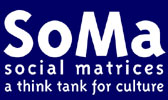
| outline | background | goals | deliverables |
RoadMarker
Project Lead: Nick West
Funding: Proboscis/Arts Council England
Outline
The goal of the RoadMarker Project is to research and demonstrate ways
to make and hear spatial annotations while driving. As an extension to
the Urban Tapestries system of marking and examining space, the annotations
can be created on the fly while driving or riding; they can also be constructed
or edited while on the web. Both drivers and passengers will be able to
listen to these annotations from a mobile device that is with them in
their vehicle.
Background
This research seeks to investigate if there are any ways to bridge the
gap that currently exists between those riding in a car and the space
through which they pass. Often, such space is only seen in quick glimpses,
or as a moving pattern of shapes passing outside the window. Although
ways of learning about the roadside spaces certainly exist – such
as historical markers and guidebooks – these adjuncts are likely
to be used only for holiday excursions, not for everyday trips.
It’s this gap of information, connection, and the ability to intervene that RoadMarker seeks to address. As a thought exercise, imagine that some way existed to hear information, stories, or other spoken constructions about the places through which you were riding. Imagine further that you could add your own spoken commentary or pieces to this tableau. If fully developed, such a system could potentially make it both easy and engaging for car or bus riders to find out about – and potentially interact with -- the surrounding area, or with those who have passed through it previously. The potential exists to add an active dimension to the often-passive experience of motor travel.
As an illustration of these themes, a demonstration of the RoadMarker system will be installed on a single car driving a pre-determined 25-mile stretch of highway. The reaction of the public to this demonstration, and their interaction with it, will inform the further steps that might be taken.
Goals
Much research has been done by automobile manufacturers on the “in-car”
experience; and the general effect of the automobile on our built environment
has been investigated by architects, sociologists, and many others. The
current project seeks to find a bridge between these two disparate fields:
to expand research into an “urbanism of the road” that includes
not only the space of the road, but those who pass through that space.
Accordingly, the RoadMarker research project intends to:
- enhance the relationship between people in moving vehicles and the space through which they move
- investigate whether a desire exists to create or listen to audio spatial annotations in cars
- find the best ways to create, “display”, and listen to audio-only spatial annotations
- build and document a demonstration of a spatial annotation system in a car
- specify
the steps needed to turn this demonstration into a working system
Critical Research Areas
In pursuit of these project goals, concentration will be focused upon the following research areas.
- in-motion
annotation technologies
Previous work in the Urban Tapestries project has concentrated on the creation and viewing of spatial annotations while stationary or walking. Making annotations in a moving vehicle requires research into entirely new technologies -- such as road databases, location tracking and approximation, ways to link displays to location, and how to balance online vs. local storage for CPUs in cars.
- audio-only
interfaces
Most spatial annotation projects have used either visual or mixed-media annotations. For driving, audio-only annotations will need to be created and presented to the user. This project will investigate the best way to present multiple, overlapping audio streams; and the best way for in-car users to create or access these streams.
- extension
of Urban Tapestries toolkit
RoadMarker will be built upon the currently-existing server and client software developed for the Urban Tapestries project. Where necessary, this toolset will be modified to work in the car environment.
- relationship
of audio to space-in-motion
As this project will be attempting to integrate people in motion with the landscape through which they are moving, it’s important to understand the theoretical ramifications that this proposed intervention will have. For example, what is the “space” that cars move through, both as seen from inside and outside the vehicle? How will this space change with the addition of a potential matrix of annotations to that space? Will the fact that the annotations will be audial rather than visual impact their effect on the space?
Deliverables
The results of the RoadMarker Project will be delivered in several stages.
As the project begins, a “Carstorming” exercise will be held
(while driving!) to evaluate the desire for in-motion audio annotation.
After most of the research is complete, a demonstration version of an audio annotation system will be installed in a car that will drive down a pre-selected 25-mile stretch of highway. The public will be invited for these drives, and their reaction (and participation) will be documented on video. An edited version of this video will be produced for display elsewhere.
A before-and-after analysis will be made of the topology of the space produced by the newly-constructed audio annotations.
A summary document will be written that will include:
- a bibliography of research sources and similar work;
- the steps undertaken to construct the RoadMarker demonstration;
- an evaluation of its strengths, weaknesses, and recommended further steps;
- and an analysis of what would be necessary to create a full working version of the demonstration.
©
2004-2005 Proboscis. Some
Rights Reserved Last updated October 25, 2006 | sitemap | Join Mailing List |
